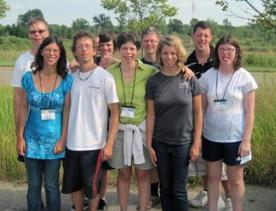You may have witnessed someone acting this way, and if you did – statistically speaking – it was a rare encounter. Aside from that, it'd be unforgettable in its own right given the stark contrast in behavior as compared to most everyone else you know.
This person clearly captured your attention. It was plain to see that s/he was friendly – very friendly, in fact – solicitous of you and curious about many aspects of your life. Questions tumbled forward, and the conversation turned personal. There were displays of affection, verbal and possibly physical; maybe some light touching or a hug. Probably not threatening – but certainly it was not what we consider normal social interaction for someone we haven't met before.
So who was this – and what was going on?
What most likely happened was that you came across someone with Williams syndrome, a condition that creates uber-friendly extroverts and afflicts between 20,000 to 30,000 people in the United States, or roughly 1 in 10,000 Americans.
Behaviorally, Williams syndrome, or WS, interferes with the brain's social interactive safeguards, leading the person to instantly trust others (which is almost always unwarranted because it comes immediately).
The interaction can be quite enjoyable, as the lack of inhibition can produce interesting and pleasant conversations. But because the sufferer is not suspicious or skeptical and her/his guard is permanently down, unfortunately there's always the chance s/he can be taken advantage of easily.
Physically, the condition also produces a range of health issues, some that are significant. According to the Williams Syndrome Association, which among other things, provides information to parents seeking answers, these issues include:
- low birth-weight and slow weight gain, leading to smaller than average stature
- heart and blood vessel problems that can be severe or even life-threatening
- musculoskeletal issues, including low muscle tone and loose joints
- dental abnormalities; slightly small, widely-spaced teeth (which can be corrected by orthodontists)
- learning disabilities and developmental delays
 That said, there are some wondrous attributes to the condition.
That said, there are some wondrous attributes to the condition.
Despite the range of challenges WS presents, parents of children with the disorder report experiencing, according to williams-syndrome.org, "unimaginable" joy that's entered their lives, given their kids' "striking verbal abilities, highly social personalities and an affinity for music."
The root of the disorder exists on the genetic level. A deleted "elastin" gene on either copy of chromosome #7 allows the hormone oxytocin to flow unimpeded to the brain. Ordinarily, elastin regulates the release of oxytocin, which helps properly shape social encounters and bonding. And that regulation provides the proper amount of the hormone to reach the brain, allowing for people to interact – but with the ability to pick up social cues and understand boundaries.
"Virtually all (98-99%) persons with typical features of WS will have a deletion of the elastin gene," according to a statement on the website for the Williams Syndrome Association (which produced the adjacent chromosome graphic).
In essence, think of the elastin genes as double doors – one door on each copy of chromosome #7 – that control the flow of oxytocin to the brain. For those with WS, one door is always open, and the rush of the "friendly hormone" never ceases.
Another unfortunate consequence of the condition is the paradox it creates, which often leads to social isolation and then depression as the sufferer matures. Those with WS are friendly and engaging and they love to interact with others. But by doing so many times they drive those same people away because "people with Williams syndrome often don’t process nuanced social cues and this makes it difficult to form lasting relationships."
There is reportedly no standard treatment for Williams syndrome.
Parents who suspect their infants or toddlers are affected can seek a DNA test that can determine presence of WS, where a special chromosome analysis can determine if one of the two elastin genes is missing.
Information on WS is not easy to come by. For example, searches on both the websites of the Centers for Disease Control and Prevention, as well as the Mayo Clinic, produced only scant references to the disorder.




